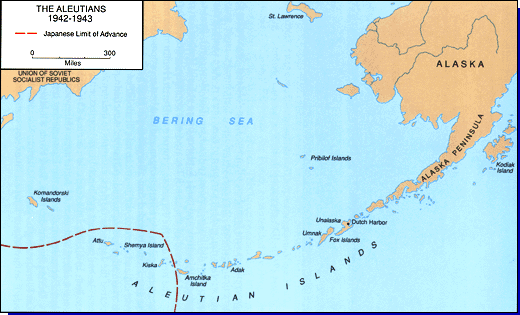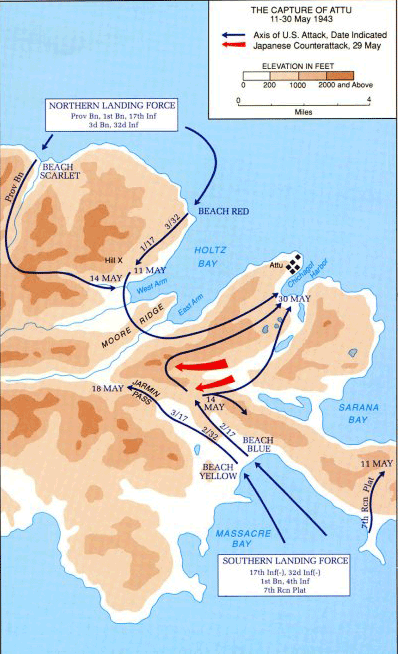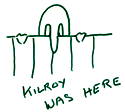The Stamford Historical Society Presents
Pride and Patriotism: Stamford’s Role in World War II
Online Edition
The Battles
The Battle of the Aleutian Islands

The Battle of the Aleutian Islands was fought between 6 June 1942 and 15 August 1943 primarily on the islands of Attu and Kiska. The Allied commanders were Thomas C. Kinkaid for the Navy, Francis W. Rockwell for the landings and Albert E. Brown for the Army. The American strength counting all personnel as of May 1943 numbered 144,000 against 8500 Japanese under Boshiro Hosogaya. A small Japanese force initially occupied the islands of Attu and Kiska and their remoteness as well as the poor weather and difficult terrain led to a campaign of more than a year to eject them. The islands had little strategic value, but as long as the Japanese held them any idea of a Northern Pacific Campaign against Japan were precluded. The American command also feared the possible use of the island as launch points against the mainland. Japan, though, lacked a long range bomber and supporting resources to operate an airbase in the Aleutians. The U.S. also longed to expel the first foreign occupation of American soil since the War of 1812.
 The struggle for the Aleutians began 3 June 1942 with a Japanese aerial bombardment at Dutch Harbor on Unalaska Island. Little damage resulted do to poor weather. On 6 June the Japanese invaded Kiska and the invasion continued on Attu the next day. They met little resistance. The Aleuts, the indigenous people of the island, had been evacuated forcibly to camps on the Alaska panhandle. The 42 who remained were taken prisoner to Otaru, Hokkaido. In August 1942 the U.S. established an airbase on Adak Island and began bombing Kiska. The 11th Air Force lost 72 planes during the campaign, mostly due to bad weather. A Naval force under Rear Admiral Charles McMorris intercepted Japanese supply convoys, and after the Battle of the Komandorski Islands on 26 March 1943, Japan abandoned attempts to resupply the Aleutian garrisons except submarines.
The struggle for the Aleutians began 3 June 1942 with a Japanese aerial bombardment at Dutch Harbor on Unalaska Island. Little damage resulted do to poor weather. On 6 June the Japanese invaded Kiska and the invasion continued on Attu the next day. They met little resistance. The Aleuts, the indigenous people of the island, had been evacuated forcibly to camps on the Alaska panhandle. The 42 who remained were taken prisoner to Otaru, Hokkaido. In August 1942 the U.S. established an airbase on Adak Island and began bombing Kiska. The 11th Air Force lost 72 planes during the campaign, mostly due to bad weather. A Naval force under Rear Admiral Charles McMorris intercepted Japanese supply convoys, and after the Battle of the Komandorski Islands on 26 March 1943, Japan abandoned attempts to resupply the Aleutian garrisons except submarines.
On 11 May 1943 despite a shortage of landing craft, unsuitable beaches for landing, equipment failures and horrible weather the Attu operation began. Many soldiers suffered frostbite, as essential supplies could not be landed, and even when landings were made, the tundra could not be crossed by the vehicles at hand. The Japanese chose to dig in far from shore rather than fight for the beaches. The battle was bloody. There were 3929 American casualties: 549 were killed, 1148 were injured and 1200 had severe cold injuries, 614 succumbed to disease and 318 died of miscellaneous causes, largely Japanese booby traps and friendly fire. About 25% of the American force was killed. On 29 May the Japanese attacked at Massacre Bay in a huge Banzai charge. The charge penetrated all the way to the rear echelon units of the American force but in the end after hand to hand combat the Japanese force was killed to the last man.
On 15 August 1943 34, 426 Allied troops including 5300 Canadians landed at Kiska to find the island completely abandoned. The Japanese had withdrawn on 28 July under to cover of fog. Allied bombers had been bombing the island for a week previous. Despite the lack of resistance there were 313 Allied casualties due to booby traps, disease, frostbite and friendly fire.
The Battle of the Aleutians is known as the Forgotten Battle, as it was overshadowed by the Guadalcanal Campaign.
The Allied forces suffered 1481 dead and 2500 wounded, sick, or frostbitten; the Japanese had 2351 dead.
 Introduction
Introduction
Veterans
Battles
Stamford Service Rolls
Homefront
Exhibit Photos
Opening Day


 Introduction
Introduction
 The struggle for the Aleutians began 3 June 1942 with a Japanese aerial bombardment at Dutch Harbor on Unalaska Island. Little damage resulted do to poor weather. On 6 June the Japanese invaded Kiska and the invasion continued on Attu the next day. They met little resistance. The Aleuts, the indigenous people of the island, had been evacuated forcibly to camps on the Alaska panhandle. The 42 who remained were taken prisoner to Otaru, Hokkaido. In August 1942 the U.S. established an airbase on Adak Island and began bombing Kiska. The 11th Air Force lost 72 planes during the campaign, mostly due to bad weather. A Naval force under Rear Admiral Charles McMorris intercepted Japanese supply convoys, and after the Battle of the Komandorski Islands on 26 March 1943, Japan abandoned attempts to resupply the Aleutian garrisons except submarines.
The struggle for the Aleutians began 3 June 1942 with a Japanese aerial bombardment at Dutch Harbor on Unalaska Island. Little damage resulted do to poor weather. On 6 June the Japanese invaded Kiska and the invasion continued on Attu the next day. They met little resistance. The Aleuts, the indigenous people of the island, had been evacuated forcibly to camps on the Alaska panhandle. The 42 who remained were taken prisoner to Otaru, Hokkaido. In August 1942 the U.S. established an airbase on Adak Island and began bombing Kiska. The 11th Air Force lost 72 planes during the campaign, mostly due to bad weather. A Naval force under Rear Admiral Charles McMorris intercepted Japanese supply convoys, and after the Battle of the Komandorski Islands on 26 March 1943, Japan abandoned attempts to resupply the Aleutian garrisons except submarines.